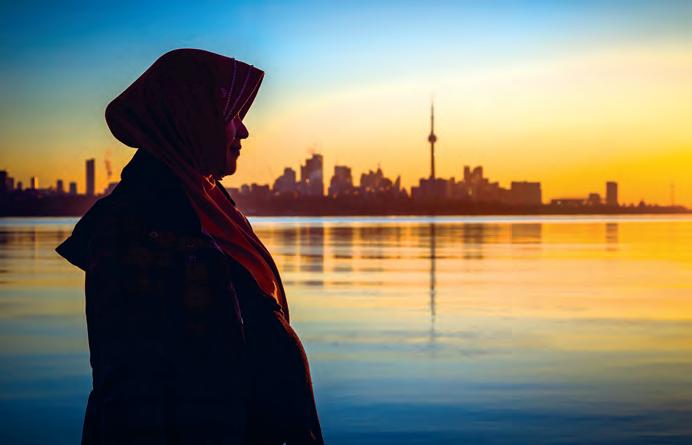
3 minute read
A Question of Identity
Muslim Canadians: A Question of Identity Remaining Muslim in a largely secular country
BY AHMAD F. YOUSIF
Advertisement
The approximately one-third of the world’s Muslims who live as religious minorities often face certain difficulties in terms of their distinctive lifestyle and maintaining their religious identity. As Islam has no geographical boundaries, Muslims of many ethnicities, languages and cultures immigrated to Canada when restrictions on non-Europeans were lifted during the 1960s.
In almost every city, one encounters Muslims and Islamic centers, associations, educational institutions and mosques. For example, in the Canadian National Capital Region — the official federal designation for the Canadian capital of Ottawa (Ontario), the neighboring city of Gatineau (Quebec) and the surrounding urban and rural communities — Islamically dressed Muslimahs have been visible, particularly since the late 1980s.
Muslims built al-Rashid, the first purpose-built mosque, in Edmonton, Alberta, in 1938. Although most Muslims are among the newest immigrants, Islam has a long history in what European settler colonists called the “New World.”
According to University of Alberta sociologist Baha Abu-Laban, who has researched the country’s Muslim demography, “the earliest record of Muslim presence in Canada dates back to 1871, when the Canadian census recorded 13 Muslim residents” (Zohra Husaini, Foreword, “Muslims in the Canadian Mosaic,” 1990).
During the last few decades, the Muslim population has increased tremendously, largely due to the political and economic unrest in many of their homelands. The country’s approximately 2 million Muslims (3.2% of the population) represent religious sects, ethnicities and languages. The large majority are immigrants or their descendants. One-third of them live in Ontario,
THOSE WHO WISH TO MAINTAIN THEIR IDENTITY OFTEN FACE DISCRIMINATION AND RACISM, DESPITE SUCH LEGISLATION AS THE CANADIAN BILL OF RIGHTS. OTHERS WHO TRY TO ADAPT TO THEIR NEW SOCIETY’S VALUES AND CULTURE OFTEN FIND THEMSELVES TRYING TO AVOID STANDING OUT IN ANY WAY.
and the absolute majority of them live in the Greater Toronto Area (GTA).
Muslim immigrants often find themselves deprived of a social structure that encourages the practice of Islam and helps them maintain their identity, for religion constitutes only a fraction of Canadians’ lives. Given that the transition is often difficult, how has this small minority coped with the enormous psychosocial challenges and maintained its identity in a largely secular but historically Christian-majority country?
Preserving one’s religious belief is central to maintaining a Muslim’s identity. Given that the “five pillars” are an essential part of a Muslim’s belief, how much they are observed may indicate the level of Islamic identity, at least quantitatively. Canadian sociologist Hans Mol (“Identity and the Sacred,” 1976) states that “religion defines man and his place in the universe,” implying that one who abandons his/her religious practice or belief steps outside one’s boundaries and consequently loses his/her identity. Practicing Muslims sometimes consider Canadian society too permissive.
In addition, social pressures often influence Muslims to stray from the religious boundaries that are crucial to their identity. Despite being aware of Islam’s strictures, some Muslim Canadians, just like their counterparts in Muslim-majority countries, do indulge. As pointed out in “Muslims in Canada: A Question of Identity” (2008), some Muslims indicated that they tolerate many of these forbidden behaviors. Accordingly, it’s difficult to understand how a Muslim can sustain his/her religious identity in such circumstances.
Muslims have come to Canada mainly for five reasons: political alienation from their homelands, economic advantages, educational opportunities, the pull of family members and friends already there and the freedom of faith and expression guaranteed by law.
Despite their initial motivation, the economic factor cannot be overlooked. Muslims have come seeking a better life. Regardless of where they live, their identity will always be challenged. Not all Muslims are tempted to stray, for some actually develop a stronger sense of identity. Those who wish to maintain their identity often face discrimination and racism, despite such legislation as the Canadian Bill of Rights. Others who try to adapt to their new society’s values and culture often find themselves trying to avoid








